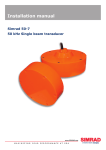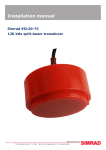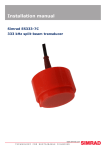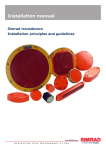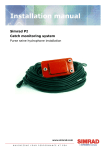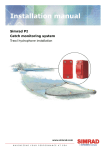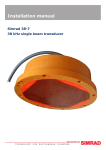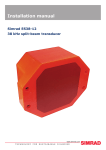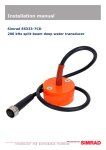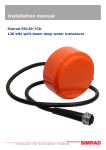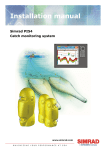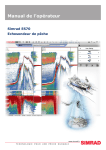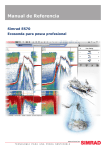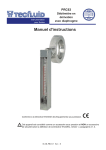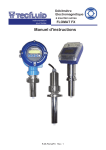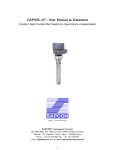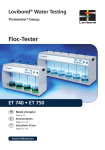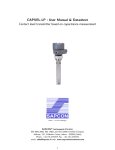Download Simrad ES38-10 - REV B Installation manual
Transcript
Installation manual Simrad ES38-10 38 kHz split-beam transducer www.SIMRAD.com MAXIMIZING YOUR PERFORMANCE AT SEA Simrad ES38-10 Installation manual This document provides a general description of how to install the Simrad ES38-10 Split-beam transducer. The information must be regarded as general guidelines and recommendations only. The installation shipyard must design and manufacture installation hardware to fit the ES38-10 transducer on each individual vessel. 305176/A August 2006 Document history Document number: 305176 / ISBN-10: 82-8066-073-9 / ISBN-13: 978-82-8066-073-2 Rev.H August 2006 Original issue. Copyright ©2006 Simrad Horten AS Disclaimer The information contained in this document remains the sole property of Simrad Horten AS. No part of this document may be copied or reproduced in any form or by any means, and the information contained within it is not to be communicated to a third party, without the prior written consent of Simrad Horten AS. Simrad Horten AS endeavours to ensure that all information in this document is correct and fairly stated, but does not accept liability for any errors or omissions. Warning The equipment to which this manual applies must only be used for the purpose for which it was designed. Improper use or maintenance may cause damage to the equipment and/or injury to personnel. The user must be familiar with the contents of the appropriate manuals before attempting to operate or work on the equipment. Simrad disclaims any responsibility for damage or injury caused by improper installation, use or maintenance of the equipment. Support If you require maintenance on your Simrad equipment, contact your local dealer. You can also contact Simrad using the following e-mail address: e-mail: [email protected] Simrad Horten AS Strandpromenaden 50 P.O.Box 111 N-3191 Horten, Norway Telephone: +47 33 03 40 00 Telefax: +47 33 04 29 87 www.simrad.com [email protected] Installation manual Table of contents INTRODUCTION ................................................................ 5 TRANSDUCER LOCATION .................................................. 6 Go deep.....................................................................................................................6 Vessel heave .............................................................................................................6 Noise from protruding objects on the hull................................................................6 Boundary water layer ...............................................................................................7 Propeller noise ..........................................................................................................7 Inclination of the transducer face .............................................................................8 Summary and general recommendation ...................................................................8 WAYS OF MOUNTING THE TRANSDUCER ......................... 10 Transducer blister ................................................................................................... 11 Box keel..................................................................................................................17 Flush mounting in a steel tank................................................................................19 Acoustic window ....................................................................................................21 Inside the hull .........................................................................................................23 Drop keel ................................................................................................................25 Retractable transducer ............................................................................................26 CABLE GLANDS ............................................................... 27 Order numbers ........................................................................................................27 Cable gland for steel hulls ......................................................................................28 Cable gland for wood or GRP hulls .......................................................................29 Cable glands for small hulls ...................................................................................30 Cable splicing .........................................................................................................31 STEEL CONDUIT .............................................................. 32 HANDLING AND MAINTENANCE ...................................... 33 Approved anti-fouling paints..................................................................................34 DRAWING FILE ............................................................... 35 ES38–10 transducer connection .............................................................................36 Outline dimensions.................................................................................................37 Mounting arrangement ...........................................................................................38 Mounting ring.........................................................................................................40 Blister assembly .....................................................................................................42 Blister design ..........................................................................................................44 305176/A 3 Simrad ES38-10 4 305176/A Introduction INTRODUCTION The purpose of this manual is the provide the basic information required to install the ES38-10 Split-beam transducer. Note that although drawings are provided to explain the installation principles, the installation shipyard must provide the final drawings required to fit each individual vessel. Also, when applicable, the installation shipyard must have the drawings and installation approved by the proper authorities. Transducer order number: KSV-202714. A cable gland kit for steel hull is included with the delivery. Other cable glands must be ordered separately. Transducer installation The next chapter in this manual provides general guidelines for transducer installation. The drawings specific for the ES38-10 transducer are located in the Drawing file. Technical specifications Refer to the ES38-10 Product specification. Additional parts The following items can be supplied by Simrad to facilitate installation: • Mounting ring: Order number 499–203336 • Transducer cable (for extension): Order number 642–078215 305176/A 5 Simrad ES38-10 TRANSDUCER LOCATION A single answer to the question where to locate the transducer cannot be given. It depends very much on the vessel’s construction. However, there are some important guide lines. Go deep The upper water layers of the sea contain a myriad of small air bubbles created by the breaking waves. In heavy seas the uppermost 5 to 10 metres may be air-filled, with the highest concentrations near the surface. Air bubbles absorb and reflect the sound energy, and may in worst cases block the sound transmission totally. Therefore, mount the transducer at a deep position on the hull. Consider the situation when the vessel is unloaded, and when it is pitching in heavy seas. WARNING The transducer must never be lifted free of the water surface. Not only will the sound transmission be blocked, but the transducer may be damaged by slamming against the sea surface. Another reason to go deep is cavitation in front of high power transducers. Cavitation is the formation of small bubbles in the water due to the resulting local pressure becoming negative during parts of the acoustic pressure cycles. The cavitation threshold increases with the hydrostatic pressure. Vessel heave Heave is the up and down movement of the vessel. It disturbs the echo traces in the echogram, so that a flat bottom is displayed as a wave. A transducer location in the middle of the vessel minimises the influence of vessel roll and pitch. Noise from protruding objects on the hull Objects protruding from the hull, such as zinc anodes, sonar transducers or even the vessel’s keel, generate turbulence and flow noise. Also holes and pipe outlets are noise sources. They may act as resonant cavities amplifying the flow noise at certain frequencies. Do not place an echo sounder transducer in the vicinity of such objects, and especially not close behind them. For the same reason, it is very important that the hull area around the transducer face is as smooth and level as possible. Even traces of sealing compound, sharp edges, protruding bolts or bolt holes without filling compound will create noise. 6 305176/A Transducer location Boundary water layer When the vessel forces its way through the sea, the friction between the hull and the water creates a boundary layer. The thickness of the boundary layer depends upon vessel speed and the roughness of the hull. Objects protruding from the hull, and dents in the hull, disturb the flow and increase the thickness of the boundary layer. The flow in this boundary layer may be laminar or turbulent. A laminar flow is a nicely ordered, parallel movement of the water. A turbulent flow has a disorderly pattern, full of eddies. The boundary layer increases in thickness when the flow goes from laminar to turbulent. The figure below illustrates the boundary layer of a vessel moving through the water. (CD17004P) A B C Boundary water layers: (A) = Turbulent flow (B) = Laminar flow (C) = Air bubbles in the water Furthermore, air bubbles in the sea water are pressed down below the hull and mixed into the boundary layer. The boundary layer is thin underneath the forward part of the vessel, and increases in thickness as it moves towards aft. If the sides of the hull are steep, some of the air bubbles in the boundary layer may escape to the sea surface along the vessel sides. It is our experience that a wide and flat bottom, with a rising angle less than around 13 degrees, is prone to giving air problems for the transducer. In any case a transducer location in the forward part of the hull is preferred in order to minimise the influence of the boundary layer. Propeller noise The propulsion propeller is the dominant noise source on most fishing vessels, research vessels, merchant vessels and pleasure crafts. The noise is transmitted through the sea water. For this reason, the transducer should be placed far away from the propeller, which means on the fore part of the hull. Positions 305176/A 7 Simrad ES38-10 outside the direct line of sight from the propeller are favourable. On small vessels with short distances it is advised to mount the transducer on that side of the keel where the propeller blades move upwards, because the propeller cavitation is strongest on the other side. The cavitation starts most easily when the water flows in the same direction as the propeller blade, and that is to some degree the case at that side of the keel where the propeller blades move downwards. Bow thruster propellers are extremely noisy. When in operation, the noise and cavitation bubbles make the echo sounder useless, almost no matter where the transducer is installed. And when not in operation, the tunnel creates turbulence, and if the vessel is pitching, the tunnel may be filled with air or aerated water in the upper position and release this in the lower position. Therefore, an echo sounder transducer should be placed well away from the bow thruster. Inclination of the transducer face Ideally, the transducer face should be mounted in parallel with the sea surface when the vessel is in normal trim, as this will provide the most accurate echo information. However, it is also very important that the water flow over the transducer face is laminar. In order to ensure laminar flow, the transducer face may be tilted slightly upwards in relation to the water flow. This allows the flowing water to meet the face directly, and assures laminar flow. The inclination angle must however be determined carefully. The angle must be small on transducers with narrow beam angles. As a rule of thumb, mount transducers with beam angles smaller than seven degrees with minimum inclination angle. The smaller beam angle your transducer has, the smaller the inclination angle can be. Ensure that you do not mount the transducer with a negative inclination angle. This may cause turbulence under the transducer face, and reduced echo sounder performance. Summary and general recommendation Some of the above guide lines are conflicting, and each case has to be treated individually in order to find the best compromise. Generally the propeller noise is the dominant factor, and a recommended transducer location is in the fore part of the hull, with maximum distance from the bow equal to one third of the total length of the hull at the water line. 8 305176/A Transducer location A (CD017004Q) L B M General recommendation for transducer location: (A) = Transducer (B) = Inclination angle (L) = Hull length at water line (M) = Maximum 1/3 of the hull length at water line (L) (CD17004C) If the vessel hull has a bulbous bow, this may well be a good transducer location, but also here must be taken into consideration the flow pattern of the aerated water. Often the foremost part of the bulb is preferable. A B Recommended location of the transducer on a bulbous hull: (A) = Thruster (B) = Transducer location 305176/A 9 Simrad ES38-10 WAYS OF MOUNTING THE TRANSDUCER There are many different ways to mount the transducer. These are the recommended methods to mount a circular transducer. Topics Transducer blister on page 11 Box keel on page 17 Flush mounting in a steel tank on page 19 Acoustic window on page 21 Inside the hull on page 23 Drop keel on page 25 Retractable transducer on page 26 10 305176/A Ways of mounting the transducer Transducer blister With a transducer with circular housing, one recommended installation method is by using a blister. The transducer blister must be designed and manufactured by the installation shipyard to fit the vessel’s size and hull shape. Mounting and clamping rings Circular transducers may be provided with mounting and clamping rings, or with drawings to allow for local production of these. The mounting ring is welded to the hole in the transducer blister, while the clamping ring fits around the edge of the transducer body. Bolts through the clamping ring into the mounting ring will then secure the transducer between them. Note that several transducers use direction guides to allow correct mounting. Smooth surface Mounting screws or bolts must not be extruding from the transducer blister. Ensure that the surface of the transducer face, the blister, the hull plating and putty around the transducer is as even and smooth as possible. Obstructions on these surfaces will create problems with turbulant flow. Horizontal support bar Large diameter transducers must be fitted with a horizontal support bar. This bar can be secured to the mounting ring using threaded rods. 305176/A 11 Simrad ES38-10 Example: Large transducer The illustration below shows a typical transducer blister designed for a large transducer. Note that due to the physical size of the transducer, a U-shaped support bar (E) is used to support the transducer. The purpose of this support is to prevent the transducer from being pushed up into the blister in heavy seas. H K G E I D (CD017010A) A C J B E F (A) = Streamlined blister (G) = Cable service loop (B) = Stiffening rib (H) = Stuffing tube (C) = Drainage holes (I) = Minimum 400 mm (D) = Inclination angle (J) = Rounded corners (E) = U-shaped support bar (K) = Air outlet (F) = Forward 12 305176/A Ways of mounting the transducer Example: Small transducer The illustration below shows a typical transducer blister designed for a small transducer. The same blister design principles as for a large transducer apply. E E A B (CD017010B) F G C D (A) = Streamlined blister (E) = Air outlet (B) = Mounting ring (F) = Forward (C) = Clamping ring (G) = Transducer cable (D) = Guide Note that the transducer cable must be provided with a cable loop inside the blister. Observe the vertical forward edge of the blister. This will guide the water to each side of the blister. 305176/A 13 Simrad ES38-10 Example: Medium sized transducer without clamping ring The illustration below shows a transducer blister designed for a medium sized transducers. The same blister design principles apply. Note that the transducer is mounted without a clamping ring, which makes it necessary to use a different mounting ring design. E E A F B I D G H C (CD017010E) (A) = Streamlined blister (E) = Air outlet (B) = Mounting ring (F) = Forward (C) = Bolt (G) = Transducer cable (D) = Self-locking threads (H) = Transducer Note that the transducer cable must be provided with a cable loop inside the blister. Observe the vertical forward edge of the blister. This will guide the water to each side of the blister. 14 305176/A Ways of mounting the transducer Common guidelines The best performance is obtained with a blister height of 40 cm or more. A streamlined shape and rounded edges reduce the flow noise. A vertical leading edge or front will guide the aerated water to the sides of the blister. The orientation of the blister should follow the water flow. The interior of the blister must be filled with sea water. Use drainage holes in the bottom and an air outlet on the top. The water pressure behind the transducer will then compensate for the outside pressure during vessel movements in rough sea. Large diameter transducers must be fitted with a horizontal U-shaped support bar. This bar can then be secured to the mounting ring using threaded rods. The transducer cable penetrates the hull in a stuffing tube. Leave an adequate loop of the cable behind the transducer for easy mounting or removal of the transducer. Toe-in The primary consideration must be to allow laminar water flow. In most cases this is achieved by designing the blister in parallel with the keel. However, if the blister is located close to the bow, the front of the blister may have a few degrees toe-in towards the bow. A C B (CD17010C) (A) = Keel (B) = Blister (C) = Toe-in angle Physical location The blister is placed on one of the sides of the hull, and the distance from the keel is a trade off between a close distance giving a turbulent flow of water in a narrow passage, and a large distance bringing the transducer higher up and also more affected by vessel roll. Normally a distance of approximately 1 m is a good compromise. 305176/A 15 Simrad ES38-10 Observe the horizontal and vertical distances (X and Y) between the keel and the transducer blister. On a medium sized vessel, the horizontal distance (X) should be approximately 1 meter. The vertical distance (Y) must in general be as small as possible. This is important to prevent the keel from shadowing the transducer beam in shallow waters. (CD17010D) B A X Y (A) = Keel (B) = Transducer blister (X) = Horizontal distance between keel and blister (Y) = Vertical distance between the blister surface and the keel 16 305176/A Ways of mounting the transducer Box keel Vessels with a box keel may use this for transducer installation. The box keel is already the deepest part of the vessel. If the box keel is too narrow to accommodate the transducer, it can be widened, either symmetrically or to one side only. In the last case the installation could also be described as a blister merged into the keel. Mounting and clamping rings Circular transducers may be provided with mounting and clamping rings, or with drawings to allow for local production of these. The mounting ring is welded to the hole in the box keel, while the clamping ring fits around the edge of the transducer body. Bolts through the clamping ring into the mounting ring will then secure the transducer between them. Note that several transducers use direction guides to allow correct mounting. Smooth surface Mounting screws or bolts must not be extruding from the box keel. Ensure that the surface of the transducer face, the box, the hull plating and putty around the transducer is as even and smooth as possible. Obstructions on these surfaces will create problems with turbulant flow. Horizontal support bar Large diameter transducers must be fitted with a horizontal support bar. This bar can be secured to the mounting ring using threaded rods. 305176/A 17 Simrad ES38-10 Example (CD17011A) The figure below illustrates a symmetrical box keel installation. D C B E A (A) = Box keel (B) = U-shaped support bar (only required on large transducers) (C) = Stuffing tube (D) = Cable in steel conduit (E) = Cable service loop 18 305176/A Ways of mounting the transducer Flush mounting in a steel tank Flush mounting is used on very large vessels with a hull so deep that no air bubbles are found below the hull, and on vessels operating in shallow harbours or waters, where a protruding blister can not be accepted. The standard procedure for flush mounting on a steel vessel is to weld a steel tank inside the hull, and mount the transducer into this tank. Mounting and clamping rings Circular transducers may be provided with mounting and clamping rings, or with drawings to allow for local production of these. The mounting ring is welded to the hole in the hull plating, while the clamping ring fits around the edge of the transducer body. Bolts through the clamping ring into the mounting ring will then secure the transducer between them. Note that several transducers use direction guides to allow correct mounting. Smooth surface Mounting screws or bolts must not be extruding from the hull plating. Ensure that the surface of the transducer face, the hull plating and putty around the transducer is as even and smooth as possible. Obstructions on these surfaces will create problems with turbulant flow. Horizontal support bar Large diameter transducers must be fitted with a horizontal support bar. This bar can be secured to the mounting ring using threaded rods. Water filled As for a blister, the interior of the tank must be filled with water. This can be accomplished by air release through a steel tube, which is extended either to open air 1.5 m above the water line or to the water outside the hull at a point higher than the tank interior. If the tube is extended to open air, drainage must be provided with leakage at the transducer flange or a separate hole in the tank bottom. 305176/A 19 Simrad ES38-10 Example Transducer mounting in a steel tank is shown in the figure below. G E F A B D (CD17012A) C (A) = Steel tank (B) = Water (C) = Drainage hole (D) = Cable service loop (E) = Steel tube for air outlet (F) = Stuffing tube (G) = Cable in steel conduit 20 305176/A Ways of mounting the transducer Acoustic window Vessels operating in arctic waters need special attention on transducer installation. Floating blocks of ice may damage even a flush mounted transducer face. For this situation Simrad offers arctic tanks in different sizes. Mounting and clamping rings Circular transducers may be provided with mounting and clamping rings, or with drawings to allow for local production of these. The mounting ring is welded to the hole inside the steel tank, while the clamping ring fits around the edge of the transducer body. Bolts through the clamping ring into the mounting ring will then secure the transducer between them. Note that several transducers use direction guides to allow correct mounting. Smooth surface Mounting screws or bolts must not be extruding from the acoustic window. Ensure that the surface of the window, the hull plating and putty around the transducer is as even and smooth as possible. Obstructions on these surfaces will create problems with turbulant flow. Horizontal support bar Large diameter transducers must be fitted with a horizontal support bar. This bar can be secured to the mounting ring using threaded rods. 305176/A 21 Simrad ES38-10 Example The transducer shown in the figure below is mounted inside the tank behind a strong acoustic window which could be made of polycarbonate. The tank is filled with oil. F G E A D B (CD017012B) C (A) = Steel tank (B) = Oil (C) = Acoustic window (D) = Cable service loop (E) = Stuffing tube (F) = Cable in steel conduit (G) = Oil inlet 22 305176/A Ways of mounting the transducer Inside the hull The transducer can also be mounted inside the hull. An installation of the transducer inside the hull, and sounding through the hull, requires a good acoustic contact between the transducer face and the hull. Build a tank around the transducer and fill it with a liquid. Oil used in hydraulic systems is a well suited liquid for this purpose. It contains no gas bubbles and is non-corrosive. Typical values of the two way loss are 3 dB for polyester, 6 dB for aluminium and 10 dB for steel. Hulls made of wood or a sandwich type with foam in the middle, attenuate the sound so much that through hull sounding must be regarded as impossible. The loss varies with the distance between transducer face and the hull. The best result is obtained when the distance is half a wavelength. Consult Simrad for advice. In addition to the loss, the beam pattern is degraded, because a larger area of the hull is set into vibrations. Mounting and clamping rings Circular transducers may be provided with mounting and clamping rings, or with drawings to allow for local production of these. The mounting ring is welded to the hole inside the steel tank, while the clamping ring fits around the edge of the transducer body. Bolts through the clamping ring into the mounting ring will then secure the transducer between them. Note that several transducers use direction guides to allow correct mounting. Smooth surface Mounting screws or bolts must not be extruding from the acoustic window. Ensure that the surface of the window, the hull plating and putty around the transducer is as even and smooth as possible. Obstructions on these surfaces will create problems with turbulant flow. Horizontal support bar Large diameter transducers must be fitted with a horizontal support bar. This bar can be secured to the mounting ring using threaded rods. 305176/A 23 Simrad ES38-10 Example The transducer shown in the figure below is mounted inside the hull. The tank is filled with oil. H G D F A B E (CD017012C) C (A) = Steel tank (B) = Oil (C) = Hull plating (D) = Cable service loop (E) = Stuffing tube (F) = Cable in steel conduit (G) = Hole for oil filling (H) = Air outlet 24 305176/A Ways of mounting the transducer Drop keel The use of a drop keel with the purpose of stabilising the vessel is well known. A drop keel is also a superior platform for echo sounder transducers. Such instrument keels have been built, mainly on research vessels, often protruding as far as three meters below the hull. At that depth, the water is free of air bubbles up to very high sea states. The vessel is then able to perform reliable acoustic measurements in open sea a larger part of the year. A B (CD017012D) C (A) = Instrument keel shaft (B) = Lowered position (C) = Bottom view 305176/A 25 Simrad ES38-10 Retractable transducer Hull units allowing the transducer to be lowered and hoisted are commonly used for horizontal looking sonars. When not in use, the transducer is retracted into a trunk. The retractable hull unit is more expensive than a blister, but on vessels with a hull where it is difficult or impossible to install a blister, it may still be worth while. The principles of a hull unit with a retractable transducer is shown below. Vessels without a keel and with a wide, flat bottom is an example where a retractable hull unit can be the only acceptable method for bringing the echo sounder transducer below the boundary layer. D (CD017012E) B E C A (A) = Transducer (B) = Trunk (C) = Transducer shaft (D) = Transducer shaft sleeve (E) = Keel 26 305176/A Cable glands CABLE GLANDS The transducer cable must pass through the hull using approved cable glands for the type of vessel in question. A steel cable gland is normally used on professional vessels with steel hulls. A bronze cable gland can be delivered as an option for vessels with wood or fibreglass hulls. Vessel not to be classified can as an option use a cable gland made of plastic. Note Simrad strongly recommends that a length of conduit is fitted around transducer cable glands made of steel or bronze and extended over the water-line inside the vessel. This precaution reduces the danger of flooding in the event of gland failure and transducers installed in this manner are also easier to replace. Some vessels may experience difficulties finding suitable areas of the hull for mounting transducer cable glands due to existing water tanks, concrete ballast or other obstacles. A possible solution in such cases is to run the transducer cables in a steel conduit aft along the hull until a suitable cable gland location is available. The respective cable gland can then be installed as described in the following instructions. Note Simrad takes no responsibility for the correct installation of cable glands, associated hull modifications and/or structural support of transducer cable penetration. These activities are subject to individual approval by the respective classification society for the vessel in question. Order numbers The cable glands described in this chapter are available as kits from Simrad. Observe the following order numbers. Steel hull cable gland kit (steel): 599-202216 Wood/GRP hull cable gland kit (bronze): 119-038200 Small hull cable gland kit (plastic): 599-202182 305176/A 27 Simrad ES38-10 Cable gland for steel hulls This cable gland kit is designed for steel vessels. It must be welded to the hull plates. F ø35 A A ø65 B C D C E (CD17008A) (A) = Steel conduit (B) = Stuffing tube, DNV approved carbon steel st52.3 (C) = Washers, 24 x 8 x 2 mm (D) = Rubber gasket (E) = Packing nipple. Make sure that you do not damage the transducer cable by tightening the packing nipple too hard! (F) = Cable to the echo sounder (or a junction box) The cable gland kit includes all of the necessary parts needed to install the unit except screws. Simrad recommends that a one inch steel conduit (that the transducer cable will be run through) with an inside threaded diameter of three-quarter inches is welded to the gland’s stuffing tube. The conduit must extend to above the vessel’s water line. 28 305176/A Cable glands Cable gland for wood or GRP hulls A bronze cable gland kit is available for wood and GRP vessels. F A E B C B C D B C (CD17008B) (A) = Packing nipple. Make sure that you do not damage the transducer cable by tightening the packing nipple too hard! (B) = Washers (C) = Rubber gaskets (D) = Hole diameter 28 mm (E) = Steel conduit (F) = Cable to the echo sounder (or a junction box) The cable gland kit includes all of the necessary parts needed to install the unit except screws. Simrad recommends that a one inch steel conduit (that the transducer cable will be run through) with an inside threaded diameter of three-quarter inches is attached to the gland’s packing nipple. This connection must be watertight, and the conduit must extend to above the vessel’s water line. 305176/A 29 Simrad ES38-10 Cable glands for small hulls This cable glands made of plastic is designed for those smaller vessels that do not need to be classified. J A B A C D E F (CD17008C) G H I (A) = Packing nut (bronze). Ensure that you do not to damage the transducer cable by tightening the packing nut too hard! (B) = Rubber gasket (C) = Plastic disk (D) = Rubber gasket (E) = Stuffing tube (F) = Backing nut (bronze) (G) = Backing washer (plastic) (H) = O-ring 42.5 x 3.0 N (I) = O-ring 39.5 x 3.0 N (J) = Cable to the echo sounder (or a junction box) Stuffing tube hole diameter: 36 mm ±1.5 mm. Apply ample amount of sealant between the backing washer (H) and the hull plate. The cable gland kit contains all the listed parts, except the sealant. Note The two O-rings must be clean, in good condition and free of cuts or other defects which could affect their watertight integrity. 30 305176/A Cable glands Cable splicing If you need to cut the transducer cable, you must splice it correctly. Note DO NOT solder the wires together with only electrical tape for insulation, as this will result in electrical noise and reduced operational performance. To splice the cable, use a metal junction box. The chassis of the junction box must be grounded, but the cable shielding must NOT be connected to the junction box ground. 305176/A 31 Simrad ES38-10 STEEL CONDUIT It is strongly recommended to lay a steel conduit from the transducer’s cable gland to the echo sounder transceiver, and to pull the transducer cable through this conduit. There are two reasons for this. • First, it will make it easier at a later stage to replace the transducer. • Second, noise and interference from other electrical equipment is greatly reduced. With a steel conduit the installation will satisfy the EU regulations for EMC interference. Without a steel conduit, there is a risk of reduced echo sounder performance. The steel conduit must be unbroken and watertight from the transducer to above the water line. From there, the cable can be pulled further, or a junction box can be installed to facilitate further connections. Note that the steel conduit must act as a continuous electrical screen all the way. To ensure proper shielding, the conduit must be electrically connected to the echo sounder transceiver chassis. Steel conduit dimensions: • minimum 35 mm inner diameter • minimum 6 mm wall thickness (4.5 mm if galvanised) If two or more transducers are installed close to each other it is possible to pull their cables in the same steel conduit, provided the conduit diameter is increased accordingly. However, for easy replacement it is recommended that each transducer has its own steel conduit. 32 305176/A Handling and maintenance HANDLING AND MAINTENANCE Do not lift the transducer by the cable. Some transducers are delivered with a cover plate on the face for protection during transport. Let this plate stay on as long as possible, but do not forget to remove it before the vessel goes into the sea. An anti-fouling paint may be applied to the transducer face. Because some paint types may be aggressive to the polyurethane in the transducer face, please consult Simrad’s list of approved paints. Note Arctic tanks have acoustic windows made of polycarbonate. These must neither be painted nor cleaned with chemicals. During dry docking of the vessel, the transducer face may be cleaned for shells and other marine fouling. Be careful not to make cuts in the transducer face. Use a piece of wood or a very fine grade emery paper. 305176/A 33 Simrad ES38-10 Approved anti-fouling paints This is Simrad’s list of approved antifouling paints on polyurethane transducer housing. Jotun Head office address: P.O.Box 2021, N-3248 Sandefjord, Norway Website: www.jotun.com. 1 Racing 2 Non-stop 3 Safeguard Universal primer (125 micron) 4 Antifouling SeaQuantum Ultra (125 micron) 5 Antifouling Seaguardian International Marine Coatings Address: World-wide offices Wesite: www.international-marine.com. 1 Intersleek tie coat + 425 FCS • BXA386/BXA390/BXA391 Grey • HKA563/HKA570/HKA571 Yellow • Mix BXA386, BXA390 and BXA391 first, then apply. When dry, mix HKA563, HKA570 and HKA571, apply. 2 Intersmooth 360 Ecoloflex SPC 3 Micron Ekstra Hempel IFA Coatings Head office address: Hempel A/S, Lundtoftevej 150, Kgs. Lyngby, DK-2800 Copenhagen, Denmark Website: www.hempel.com. 1 Hempel A/F Classic 76550 Note Refer to the manufacturer’s documentation and data sheets for a complete procedure. 34 305176/A Drawing file DRAWING FILE This chapter contains relevant drawings related to the electrical and physical installation of the ES38-10 Split-beam transducer. Note The mechanical drawings are for information and guidance only. They are not in scale. All dimensions are in mm unless otherwise is noted. Observe the maximum torque (31 Nm) when the transducer is bolted into the mounting ring! The original installation drawings are available on PDF and AutoCad format. Visit www.simrad.com to download. In addition to the drawings available in this chapter, an additional drawing is provided on the web site. This is drawing 599–203664 describing an optional steel tank for the transducer. Drawings ES38–10 transducer connection on page 36 Outline dimensions on page 37 Mounting arrangement on page 38 Mounting ring on page 40 Blister assembly on page 42 Blister design on page 44 305176/A 35 Simrad ES38-10 ES38–10 transducer connection This is the termination of the transducer cable from the ES38–10 split-beam transducer to the transducer socket on the ES60 and EK60 General Purpose Transceiver Unit (GPT). The other end of the cable is permanently fixed to the transducer. All transducer cables must be run in steel conduits. Use a flexible conduit closer to the transceiver. 2 3 B FWD 1 Sections seen from top of the transducer ES38-10 transducer cable 1 White Black 2 White Black 3 White Black A GPT Transducer socket N M C L D K E F H J Junction Box (1:1) (Optional) J H F E D C Screen Connect to plug housing W802-8 Rev.A ES38-10 Transducer cable termination There are four pairs in the transducer cable, each with one black and one white cable. Each pair is marked with a small label identifying the transducer section. Pair number 4 is not used. Note The cable screen must not be connected to the ship’s ground through the junction box. The cable screen can be connected to the junction box chassis, but the junction box chassis must not be connected to ship’s ground. 36 305176/A Drawing file Outline dimensions Arrow indicating "forward" ø310 Cable length: 20 m Cable diameter: 10.6 ±0.5 mm ø340 ø150 ø71 30o R5 ø12 12 150 100 ø336.5 Note: All measurements are in mm unless otherwise specified. The drawing is not in scale. 305176/A ø18 CD017015F Page 1 of 1 834-203329 Rev.B 37 Simrad ES38-10 Mounting arrangement Air outlet Steel blister, to be manufactured by the installation shipyard (Simrad dwg 830-203430) Mounting ring, may be supplied by Simrad (Simrad dwg 499-203337) FORWARD Self-locking threads WARNING: Do not lift the transducer by the cable! Marking on transducer indicates "forward" Washer Bolt M10x100 Maximum torque 31 Nm! Note: All measurements are in mm. The drawing is not in scale. 38 CD017015D Page 1 of 2 820-203428 Rev.B 305176/A Drawing file Recommended transducer location Approx 3 deg Minimum 400 mm Min. X/4 X 1 - Aft starboard Air/water outlet (optional) near the echo sounder, above water level 2 - Aft port 3 - Fore 4 - Not used Screen to echo sounder chassis ø35 Steel conduit ø65 Stuffing tube Washer Rubber gasket Washer Packing nipple Service loop on cable Note: All measurements are in mm. The drawing is not in scale. 305176/A Steel conduit: Recommended to minimize electrical interference. Minimum inside diameter: 35 mm Wall thickness: 6 mm (or 4.5 mm if galvanized conduit is used) 2 Minimum 400 mm 3 FWD 1 Sections seen from top of the transducer CD017015D Page 2 of 2 820-203428 Rev.B 39 Simrad ES38-10 Mounting ring Surface treatment: 1) Sand blast to SA 2.5 2) One coating of red ferric oxide primer 310 30° 60° M10 SL* (x6) Ø0.2 The self-lock threads (SL*) must be made in accordance with Simrad procedure 842-202125. Self-lock taps can be supplied by Simrad. Note: All measurements are in mm. The drawing is not in scale. 40 CD017015G Page 1 of 2 871-203337 Rev.B 305176/A Drawing file Material: St 52-3N (DIN 17100) Round steel or plate 125 ±1 21 ±1 14 ±2 6.3 100 +0/-0.5 45° ø360 ±1 ø348 ±1 ø342 +0.5/-0 ø155 ±1 Chamfer 3 x 45° Note: All measurements are in mm. The drawing is not in scale. 305176/A R1 (max) CD017015G Page 2 of 2 871-203337 Rev.B 41 Simrad ES38-10 Blister assembly Surface treatment: To avoid acoustic noise, it is very important that the surface of the blister is smooth. Avoid cracks, dents and other unevenness. 1) Sand blast after grinding to SA 2.5 2) Apply one coat of red ferric oxide prime 3) No concavity is accepted 4) Maximum convexity is 3 mm 5) Small local hollows (max 1 mm!) can be accepted 510 347 Drainage hole Ø10 to 15 mm (A) 30° (A) Steel blister Stiffening ribs Mounting ring 602 1420 Note: All measurements are in mm. The drawing is not in scale. 42 CD017015H Page 1 of 2 830-203430 Rev.B 305176/A Drawing file (B) Air vent holes R25 to 50 mm 100 (B) (A - A) (B - B) Depends on dead rise Minimum 400 mm 243 Note: All measurements are in mm. The drawing is not in scale. 305176/A CD017015H Page 2 of 2 830-203430 Rev.B 43 Simrad ES38-10 Blister design Bottom plate must be smooth and even! 1) No concavity is accepted 2) Maximum convexity is 3 mm 3) Small local hollows (max 1 mm!) can be accepted 10° 15° 30° 23° (A) R1740 (A) R525 R150 R1030 R10 45° R1740 5° (486) 602 1420 Note: All measurements are in mm. The drawing is not in scale. 44 CD017015I Page 1 of 2 871-203432 Rev.A 305176/A Drawing file Materials: Steel plate, Fe 510 D1 (St 52-3 N), 6 and 10 mm (B) 10 (A - A) (B) 6 Height depends on dead rise 6 (B - B) Minimum 400 mm R10 Note: All measurements are in mm. The drawing is not in scale. 305176/A CD017015I Page 2 of 2 871-203432 Rev.A 45 Simrad ES38-10 A E Acoustic window installation, 21 Air bubbles, 6 Anti-fouling paint, 34 Arctic tank cleaning, 33 painting, 33 polycarbonate, 33 EMC interference, 32 ES38–10 Transducer connection, 36 B Blister installation, 11 Blister assembly drawing, 42 Blister design drawing, 44 Boundary water layer, 7 Bow thrusters noise, 8 Box keel installation, 17 C Cable ES38–10 transducer, 36 splicing, 31 Cable gland GRP hull, 29 small hull, 30 steel hull, 28 Cavitation, 6 Clamping ring acoustic window, 21 blister, 11 box keel, 17 flush mounting, 19 inside hull, 23 Conduit, 32 Connection ES38–10 transducer, 36 D Depth, 6 Drawing Blister assembly, 42 Blister design, 44 Mounting arrangement, 38 Mounting ring, 40 Outline dimensions, 37 Drawing file, 35 46 cavitation, 6 propeller, 7 protruding objects, 6 O F Flush mounting flush mounting, 19 Outline dimensions drawing, 37 P G GPT Connection ES38–10 transducer, 36 GRP hull cable gland, 29 H Paint anti-fouling, 34 Propeller noise, 7 Protruding objects, 6 S Layer boundary, 7 Location recommendation, 8 transducer, 6 Splicing cable, 31 Steel conduit, 32 Steel hull cable gland, 28 Steel tank flush mounting, 19 Support bar acoustic window, 21 blister, 11 box keel, 17 flush mounting, 19 inside hull, 23 Surface acoustic window, 21 blister, 11 box keel, 17 flush mounting, 19 inside hull, 23 M T Maintenance, 33 Mounting arrangement drawing, 38 Mounting ring acoustic window, 21 blister, 11 box keel, 17 drawing, 40 flush mounting, 19 inside hull, 23 Transducer depth, 6 location, 6 recommended location, 8 Transducer cable splicing, 31 Handling, 33 Heave vessel, 6 I Inclination angle, 8 Installation drawings, 35 L V Vessel heave, 6 N Noise air bubbles, 6 bow thrusters, 8 W Water filled flush mounting, 19 305176/A ISBN-10: 82-8066-073-9 ISBN-13: 978-82-8066-073-2 ©2006 Simrad Simrad Horten AS Strandpromenaden 50 P.O.Box 111 N-3191 Horten, Norway Telephone: +47 33 03 40 00 Telefax: +47 33 04 29 87 www.simrad.com [email protected]




















































